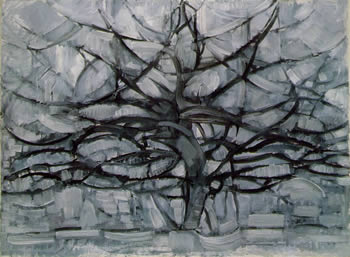 Grey Tree (1911).
Grey Tree (1911).
It was Picasso and Braque that instigated the use of black lines within their work. Braque being more playful, loved to scatter them about over his canvas. Picasso used them as a framework from which to hang the rest of his paintings. The lines became the framework of the real world. Mondrian saw this and understood the potential of the idea as he himself had started to use the black lines as a grid lying on the surface of the picture. This is seen easily in Landscape with Trees (1911/2) and is exemplified by his Grey Tree (1912) where he tries to convey the mass of foliage and the misty grey air in an apple orchard. This painting has a very clear and well defined linear structure.
In the years to come Mondrian perfected his abstract style. He found areas of the city of Paris that he became fascinated with: broken down buildings, demolished houses and the areas around and between them gave him new insight into his own world. They appeared as huge abstract pictures to Mondrian, and he loved to stand and watch them.
Mondrian still wanted to become a great painter like Rembrandt, or van Gogh so he returned to nature and the great themes of classical landscape painting. He found that some of these were more appropriate to his new found style of painting, more so than the Parisian houses. He saw that nature could be regular and repeatable and his Dutch coastal landscapes were a good example. Mondrian painted the sea in his new style using his cubist vision, resulting in criss-crossing lines enclosed within an oval shape.